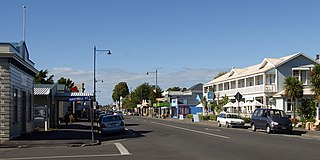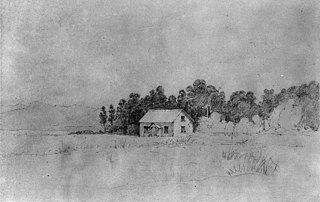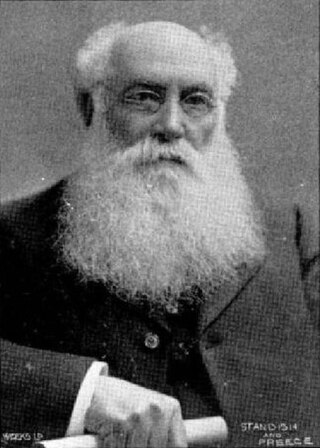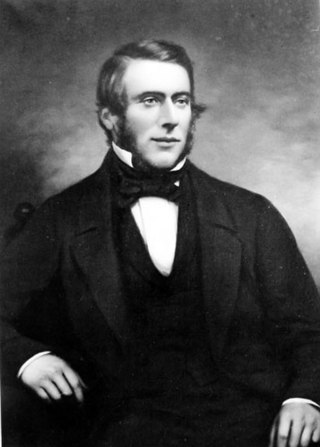
Greytown, population 2,202, is a rural town in the centre of the Wairarapa region of New Zealand, in the lower North Island. It is 80 km north-east of Wellington and 25 kilometres southwest of Masterton, on State Highway 2. It was awarded the title of New Zealand's Most Beautiful Small Town 2017.

George Street is the main street of Dunedin, the second largest city in the South Island of New Zealand. It runs for two and a half kilometres north-northeast from The Octagon in the city centre to the foot of Pine Hill. It is straight and undulates gently as it skirts the edge of the hills to its northwest. South of The Octagon, Princes Street continues the line of George Street south-southwest for two kilometres.

Moray Place is an octagonal street which surrounds the city centre of Dunedin, Otago, New Zealand. The street is intersected by Stuart Street, Princes Street and George Street. Like many streets in Dunedin, it is named for a street in the Scottish capital Edinburgh.

Goldie's Brae is a historic building in Wadestown, Wellington, New Zealand classified as a "Category I" historic place by the New Zealand Historic Places Trust. It is considered remarkable for its relatively new construction material, concrete, and its eccentricity of design. It was designed by its original owner Dr Alexander Johnston, the Provincial Surgeon of Wellington.

Solway is an old-established residential suburb near the Waingawa River in the south-western part of Masterton, the principal town in the Wairarapa Valley of New Zealand's North Island. It was a small part of Manaia run on which Masterton is built. It takes its present name from Solway House built in 1877 for W. H. Donald.

Colombo Street is a main road of the city of Christchurch, New Zealand. It runs south-north through the centre of Christchurch with a break at Cathedral Square. As with many other central Christchurch streets, it is named for a colonial Anglican bishopric, Colombo, Sri Lanka in what at the time was known as Ceylon. Parts of the street which run through Sydenham were known as Addison Street during the 1880s, and some parts were known as Colombo Road.

The Government Gardens is a public park, partly laid out as gardens, located beside Lake Rotorua in central Rotorua, Bay of Plenty, North Island, New Zealand. It was built by the government as a tourism attraction, and is still a major tourism destination in New Zealand.

Ohinetahi is a valley, historic homestead, and formal garden on Teddington Road, Governors Bay, Christchurch, Canterbury region, New Zealand. Ohinetahi valley is situated at the head of Lyttelton Harbour, at the base of the Port Hills. While the Ohinetahi Homestead is considered to be a significant historic building in the small settlement of Governors Bay, the formal garden of Ohinetahi is considered to be one of New Zealand's finest. Amongst the early owners of Ohinetahi were Canterbury pioneer William Sefton Moorhouse and Thomas Potts, New Zealand's first conservationist. Sir Miles Warren, architect of the Christchurch Town Hall, was the last private owner, and gifted it to New Zealand.

Cecil Walter Wood was a New Zealand architect. He was the dominant architect in Canterbury during the interwar period.
John Howell was a New Zealand whaler, trader, pastoralist and politician.

Samuel Charles Farr was a 19th-century builder and architect in Christchurch, New Zealand. He intended to emigrate from England to Auckland, but significant shipping problems saw him end up in Akaroa in 1850 instead. From 1862, he lived in Christchurch. Farr has a number of firsts against his name: the first marriage in Canterbury, he designed Akaroa's first church, designed New Zealand's first iron verandahs, and he started Sunday schools in Canterbury. As a leading member of the Acclimatisation Society, he stocked almost every lake and river in Canterbury with fish and was instrumental in introducing the bumblebee to New Zealand. His most notable building was Cranmer Court, the former Normal School, in the Christchurch Central City; this building was demolished following the February 2011 Christchurch earthquake.

Golder Cottage is one of the oldest surviving colonial houses in Upper Hutt, New Zealand. The house is used as a museum of colonial domestic life.

Highwic is a 19th-century house in Auckland, New Zealand, which is listed by Heritage New Zealand as a Category I structure. The house was built in 1862 for Alfred Buckland, a wealthy colonial settler and landowner. The building sits in an elevated position above Newmarket.

John Deans was, together with his brother William, a pioneer farmer in Canterbury, New Zealand. He was born in Kirkstyle, Riccarton, Scotland. Their Riccarton farm in New Zealand was the first permanent settlement by immigrants on the Canterbury Plains. Deans returned to Scotland in 1852 to marry Jane McIlraith. They returned to New Zealand, where he died from tuberculosis at Riccarton Farm on 23 June 1854, not before he had asked Jane to keep the adjacent Riccarton Bush in perpetuity. The Deans had one son, also called John. The Deans brothers named the Christchurch river Avon after the stream on their grandfather's farm.
Glenfalloch is a private garden and restaurant near Macandrew Bay on Otago Peninsula, New Zealand. The gardens are owned and run by the Otago Peninsula Trust.

The Warehouse Precinct is an urban area of the New Zealand city of Dunedin. Sited on reclaimed land at the northernmost tip of the Southern Endowment, it lies between 1 and 2 kilometres south of The Octagon, the city's centre.

Deans Cottage is the oldest remaining building in Canterbury, New Zealand. Located in the Christchurch suburb of Riccarton, it was part of the Riccarton estate. Built in late 1843, members of the Deans family lived in the cottage until 1856. Today, the relocated cottage is a museum, placed between Riccarton House and Riccarton Bush.
















